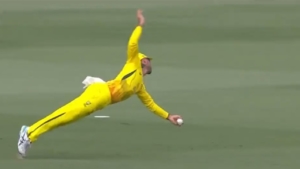The Ultimate Guide to Saving Runs as a Fielder
The fast paced nature of T20 cricket has been the catalyst for some seriously exciting cricket, however one area of the game that is often under appreciated is the importance of quality fielding. I want you to think of a player that comes to mind when you think of the best fielder in the game, who is it? What do they do well? How do they do these things? In this blog I will be dissecting a certain fielder who I believe epitomises a great fielder and looking into what traits you can emulate to take your fielding to the next level.
That fielder is… Glen Maxwell.
Glen Maxwell is a superstar in every area of the game, and his impact in the field is just one reason he is seen as the complete T20 cricketer. Here are 4 things that Glen does in the field that make him an absolute superstar….
1. Anticipation
Maxy is by far one of the best backward point (and everywhere else) fielders in the world, with his ability to anticipate what shot the batter is going to play being a key factor in this. Anticipation is the ability to take small ques from something and understand what is going to happen before it is going to happen. It requires a deep level of focus and understanding of the situation which in return allows you to make quick and game changing decisions.
Some examples of these cues are movements form a batsman such as:
- Are they loading up with a big backswing or is it short?
- Are they moving a certain way on the crease to access different shots?
- Are they opening or closing their bat face?
These are physical cues that are clearly visible, however there are also some theoretical cues that can help in decided what a batsman is trying to do such as:
- What stage of the game are we in?
- Where am I fielding and what way are they likely to hit it?
- What are the batsman's strengths?
- Where have they hit the ball previously?
- Is there a weakness in the field they might be looking to exploit?
As you start to develop your understanding of these cues, it becomes much easier to adapt instantly and in return, get to the ball quicker. By getting to the ball quicker or reacting to a ball in the air faster, you will ultimately be at a much greater chance of stopping a run, getting that run out or taking that catch! These can often be game defining moments and moments that Glen Maxwell pulls off more consistently than anyone else.
2. Find your Right Fielding Position
Maxy is a gun fielder, and with this comes the responsibility of finding himself in hot spots at all times. Hot spots are areas in which see the most traffic, or are possibly the hardest to field at. Think backward point, long on, big boundaries & key strength areas for batsman…
It is important to remember that T20 is a game of fine margins, and having the right people in the right positions, at the right time can make all the difference to the result of the game. Think about it like this, if your worst fielder is seeing the most amount of traffic, they are going to make more mistakes and ultimately cost runs. What is important here is that you are able to realistically and thoughtfully identify your strengths and weaknesses, and communicate these with your captain in order to get yourself in the best position possible, even if this is fine leg to fine leg!
Some examples of fielding traits that are aligned with certain positions are:
High traffic outfield areas for catches and ground fielding (long on, long off, cow corner, deep square)
- Strong arm
- Fast across the ground
- Good hands
- Good anticipation
High traffic infield areas for catches and ground balls (cover, point, mid wicket)
- Great anticipation
- Good catching
- Good reactions
- Good agility
This season we have launched a brand new T20 training program aimed at allowing players to focus on developing the specific skills required for white ball cricket, for any players or parents interested, click the banner below.
3. Do the Miles - Get the Smiles
A saying not often associated with cricket, however extremely relevant when talking about being a great fielder. I would love to have a tracker on Glen Maxwell and see exactly how many kilometres he runs during a 20 over stint in the field… It would be huge!
There are 2 parts to this, the first is the kilometres he would be doing to get himself into the right position. We often see amateur cricket players who take the easy option and don’t move themselves into the correct position after each over as it is ‘too hard’, however this can have large ramifications on the team. Maxy will often have to run from one end of the field to the other, just to get himself into hotspots as frequently as possible. While this effort area does sound simple enough, it requires extra fitness and great awareness to achieve however is one all aspiring T20 cricketers should do.
The second part refers to a player moving every single ball. You may have heard the saying ‘everyone moving in the field’, as this is an extremely crucial aspect of fielding in T20 cricket. Even if a player is on the other side of the boundary to where the ball was hit, they must run up to the 30 yard circle to ensure no overthrows are possible. This must become instinctive in players as without that instinct it is far too easy to simply forget. In addition to this, it creates a certain ‘buzz’ in the field which will only lift your team up.
4. Throw the Ball Into the Ground from the Outfield
The final 1%er you will often see Glen do is throwing the ball into the keeper or bowler with a bounce from the boundary. The first thing this does is allow in general for a more accurate throw, where if done correctly, skids on at a top of the stumps height making it much easier for the fielder over the stumps to take. The second thing this does is legally softens up the ball. As the ball gets softer, it becomes more challenging for the batter to connect cleanly with, which could ultimately be the difference between a boundary and a wicket. While this is a great tactic and should be applied where possible, it is important to remember that you are only allowed 1 bounce to the keeper and it must be thrown from outside the 30 yard circle…
I hope you can take some of these tips into your next T20 match, and make sure you have a look at just what Maxy is doing in the field next time you’re watching the big bash of an Australia game!
Author: Josh Matthews
QLD Coach & Programs Manager




